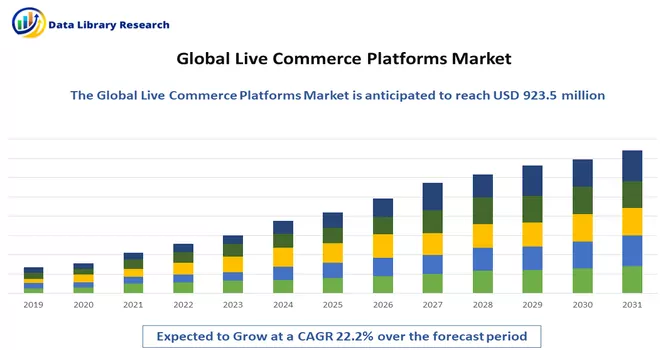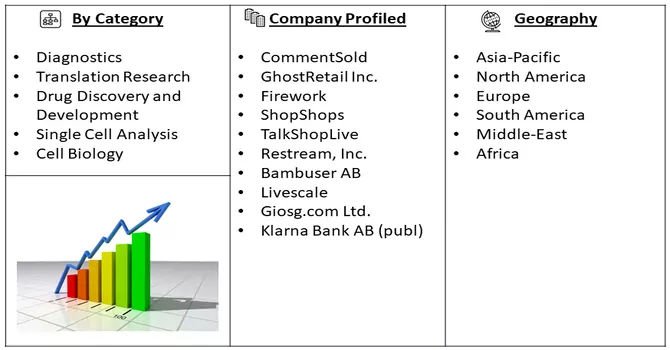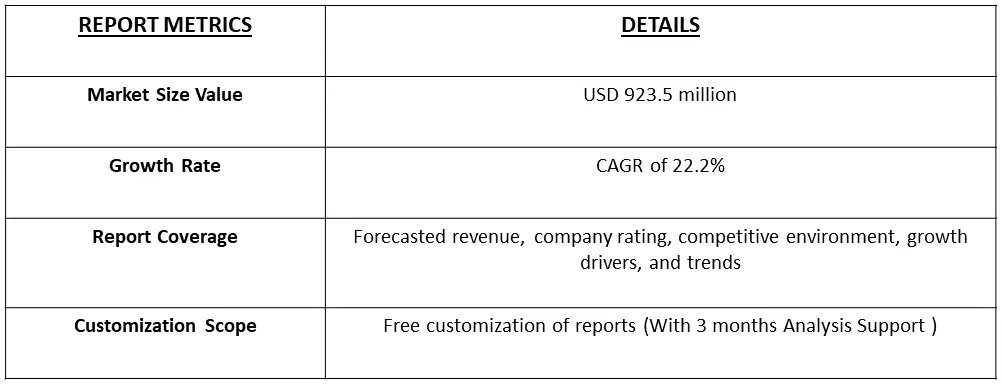The global live commerce platforms market size was estimated at USD 923.5 million in 2023 and is expected to grow at a compound annual growth rate (CAGR) of 22.2% from 2024 to 2031.

Get Complete Analysis Of The Report - Download Free Sample PDF
Live commerce platforms refer to digital environments that enable real-time, interactive shopping experiences through online channels. These platforms integrate elements of e-commerce and live streaming, allowing sellers, brands, or influencers to showcase products or services in a live video format. Consumers, in turn, can participate in the live broadcast, engage with the presenter, ask questions, and make purchases directly during the live session. Live commerce platforms leverage the immediacy and interactivity of live video streaming to create a dynamic and engaging shopping experience, simulating aspects of in-person retail interactions. This form of digital retail has gained popularity for its ability to blend entertainment, social interaction, and e-commerce, providing a more personalized and interactive way for businesses to connect with their audience and drive sales.
Anticipated market growth is attributed to several key factors, including the expansion of e-commerce and the flourishing live commerce trend. The widespread adoption of social media platforms and the burgeoning influencer culture further contribute to this trajectory. Notably, the industry stands to benefit significantly from technological advancements and the innovative approaches of market participants. The integration of cutting-edge technologies such as augmented reality/virtual reality (AR/VR), artificial intelligence (AI), and 3D adds a layer of opportunity for enhancing the live stream experience. This confluence of technological sophistication and creative strategies not only enriches the overall market landscape but also opens up avenues for heightened user engagement and novel interactive possibilities. As the live commerce sector continues to evolve, the synergy of these influential factors positions the industry for sustained growth and a dynamic, immersive consumer experience.
Market Segmentation: The Live Commerce Platforms Market is Segmented By Category (Apparel & Fashion, Cosmetics & Personal Care, Consumer Electronics, and Furnishing), and Geography (North America, Europe, Asia-Pacific, South America, and Africa). The report offers the market size and forecasts in terms of volume in metric tons and value in USD thousand for all the above segments.

For Detailed Market Segmentation - Download Free Sample PDF
The Live Commerce Platforms market is experiencing transformative trends, marked by the integration of e-commerce, synergies with social media channels, and the influential role of influencers in hosting shopping events. Advanced technologies like AR, VR, and AI are enriching the interactive aspects of live commerce, fostering innovative and immersive shopping experiences. Mobile commerce dominates the landscape, with dedicated apps catering to the on-the-go nature of consumers. Data-driven personalization, global market expansion, and the introduction of interactive features such as live chat contribute to a dynamic and engaging environment. Live commerce is diversifying across various product categories, and there is a notable trend towards incorporating sustainability and social impact into live commerce events, reflecting a broader shift towards values-driven consumerism. These trends collectively shape the evolving landscape of Live Commerce Platforms, emphasizing the importance of technology, consumer engagement, and the creation of personalized, interactive, and socially conscious online shopping experiences.
Market Driver:
Growth of E-Commerce and Technological Advancement
The growth of e-commerce, coupled with rapid technological advancement, has significantly reshaped the landscape of online retail in recent years. E-commerce has witnessed an unprecedented surge, driven by factors such as the increasing digitalization of businesses, changing consumer preferences, and the convenience of online shopping. The proliferation of mobile devices has further fueled this growth, enabling consumers to make purchases anytime, anywhere. Technological advancements, including secure payment gateways, sophisticated data analytics, and artificial intelligence, have played a pivotal role in enhancing the e-commerce experience. Personalized recommendations, targeted marketing strategies and streamlined logistics powered by innovative technologies have contributed to a seamless and efficient online shopping journey. The integration of augmented reality (AR) and virtual reality (VR) technologies is providing immersive and interactive experiences for customers, bridging the gap between online and in-store shopping. As e-commerce continues to expand its reach and influence, ongoing technological advancements promise to further revolutionize the way consumers engage with online platforms, ensuring a future where convenience, personalization, and innovation converge in the digital retail space.
Growth Opportunity for Employment and Entrepreneurship
The evolving landscape of the digital economy presents significant growth opportunities for both employment and entrepreneurship. The proliferation of technology and the expansion of online platforms have created diverse avenues for job seekers and aspiring entrepreneurs alike. On the employment front, the demand for skilled professionals in areas such as software development, data analysis, digital marketing, and e-commerce management has surged. Additionally, the gig economy, facilitated by platforms offering freelance and part-time opportunities, provides flexible employment options for individuals seeking autonomy in their work. Simultaneously, the digital era has empowered entrepreneurship by lowering entry barriers and offering global reach. E-commerce platforms, social media, and online marketplaces enable entrepreneurs to showcase and sell their products or services to a vast audience. The rise of remote work has facilitated the establishment of digital businesses without geographical constraints. Moreover, advancements in fintech and crowdfunding have streamlined access to capital, fostering the growth of startups. Thus, the growth opportunities presented by the digital economy for both employment and entrepreneurship are substantial. The flexibility, global reach, and accessibility afforded by technological advancements create a conducive environment for individuals to explore various career paths, contribute to economic growth, and shape the future of work in the digital age.
Market Restraints:
Technical Challenges and Security Concerns
Incorporating cutting-edge technologies like augmented reality (AR) and virtual reality (VR) into Live Commerce Platforms presents inherent technical complexities. The seamless execution of live streaming, particularly when integrating interactive features, necessitates a sturdy technical infrastructure and dependable high-speed internet connectivity. Ensuring a glitch-free and immersive experience for users demands meticulous attention to technical details and the ability to handle the substantial data load associated with these advanced features. Moreover, the live nature of these platforms raises paramount concerns regarding data security and privacy. Given the handling of personal and financial information during live transactions, the onus is on businesses to implement robust security measures. Safeguarding both the business and consumer from potential cyber threats and breaches becomes imperative. This involves the implementation of stringent encryption protocols, secure payment gateways, and adherence to industry standards to instil confidence among users and mitigate the risks associated with the dynamic and interactive environment of live commerce.
The COVID-19 pandemic profoundly impacted the Live Commerce Platform market, catalyzing a rapid shift in consumer behavior towards online activities. With physical stores closed and lockdown measures in place, the adoption of digital platforms, particularly those offering live commerce experiences, witnessed an unprecedented surge. Live commerce became an integral component of the e-commerce landscape, providing brands and retailers with a dynamic channel to connect with consumers in real-time, replicate in-store interactions, and enhance the online shopping experience. The pandemic accelerated the integration of live streaming features into e-commerce platforms, fostering remote shopping and enabling consumers to explore products and make purchases from the safety of their homes. Influencer marketing gained prominence, with influencers leveraging live commerce events to engage audiences and promote products. Technological enhancements, such as augmented reality features and virtual showrooms, further elevated the user experience, while the global reach of live commerce platforms transcended geographical boundaries. Beyond transactional experiences, live commerce incorporated entertainment elements, making the online shopping journey enjoyable and memorable. The lessons learned and innovations introduced during the pandemic are expected to shape the continued growth and evolution of live commerce in the post-pandemic era.
Segmental Analysis:
Cosmetics & Personal Care Segment is Expected to Witness Significant Growth Over the Forecast Period
Cosmetics and Personal Care industry, a dynamic and multifaceted sector, encompasses a wide array of products designed to enhance personal grooming, hygiene, and aesthetics. This expansive industry includes skincare, haircare, makeup, fragrances, and various other products catering to individual well-being and appearance. The cosmetics segment focuses on products designed to enhance or alter the physical features of the face and body, ranging from foundations and lipsticks to eyeshadows and mascaras. Skincare is dedicated to maintaining and improving the health of the skin through cleansers, moisturizers, serums, and sunscreens. Haircare products aim to nourish and style hair, offering solutions for cleansing, conditioning, and styling. Fragrances contribute to personal expression and mood enhancement through a diverse range of scents. The industry is characterized by a constant influx of innovations, driven by consumer preferences, technological advancements, and a growing emphasis on sustainability. The rise of clean and organic beauty, the integration of technology in product formulations, and an increasing focus on inclusivity and diversity reflect the evolving dynamics within the Cosmetics and Personal Care sector. Additionally, the industry is influenced by global beauty trends, cultural shifts, and a heightened awareness of the environmental impact of beauty products, leading to a surge in sustainable and eco-friendly formulations. E-commerce has played a transformative role, offering consumers convenient access to a vast array of products, personalized recommendations, and the ability to explore and compare brands effortlessly. Social media platforms serve as influential spaces for beauty trends, product reviews, and user-generated content, shaping consumer choices and fostering a sense of community within the beauty and personal care sphere. Thus, the Cosmetics and Personal Care industry is a vibrant and ever-evolving landscape, driven by innovation, consumer preferences, and societal trends. The convergence of beauty, technology, and sustainability continues to redefine the industry, offering exciting opportunities for brands to connect with a diverse and discerning consumer base.
North America Region is Expected to Witness Significant Growth Over the Forecast Period
North America is poised to experience the highest Compound Annual Growth Rate (CAGR) from 2024 to 2030, propelled by the extensive embrace of e-commerce and the escalating prevalence of mobile and internet connectivity. The region's surge is further amplified by the seamless integration of live commerce platforms with popular social media channels, enhancing the visibility and reach of live commerce events. The rising adoption of e-commerce, coupled with the ease of services facilitating it, has created a favourable environment for the growth of live commerce platforms. The United States, in particular, stands out as a significant hub for e-commerce and technological advancements, providing a robust foundation for the continual evolution and expansion of the live commerce sector.

Get Complete Analysis Of The Report - Download Free Sample PDF
Major market players actively pursue strategies such as expanding their production capabilities, engaging in mergers and acquisitions, and conducting research and development initiatives to maintain a competitive edge in the industry. This involves increasing their capacity for manufacturing, acquiring other companies or merging with them to strengthen their market position, and investing in innovative research and development efforts. These strategic moves are crucial for staying ahead of competitors, enhancing market share, and ensuring sustained growth in the dynamic business environment. The commitment to these initiatives underscores the players' proactive approach in adapting to market trends, meeting evolving customer demands, and securing a prominent position in the competitive landscape. Key Live Commerce Platform Companies:
Recent Developments:
1) In October 2023, TalkShopLive, a U.S.-based live commerce platform, unveiled a new mobile app tailored for merchants, introducing enhanced functionality. The app empowers users with a suite of platform tools, including the ability to view detailed product information, spotlight key products during sales events, monitor sales metrics, engage with customers in real-time during broadcasts, and receive ratings.
2) In February 2023. This collaboration aims to elevate and simplify the livestream shopping experience for sellers within the U.S. market. The partnership rollout will occur gradually, with the initial phase concentrating on assessing revenue metrics tied to various parameters such as the number of participating sellers, show creators, TikTok creators, and the overall performance of TikTok live sales. This collaborative effort underscores the industry's commitment to innovation and improving the accessibility of live commerce through strategic alliances and cutting-edge technology.
Q1. What was the Live Commerce Platforms Market size in 2023?
As per Data Library Research the global live commerce platforms market size was estimated at USD 923.5 million in 2023
Q2. What is the Growth Rate of the Live Commerce Platforms Market?
Live Commerce Platforms Market is expected to grow at a compound annual growth rate (CAGR) of 22.2% over the forecast period.
Q3. What are the Growth Drivers of the Live Commerce Platforms Market?
Growth of E-Commerce and Technological Advancement and Growth Opportunity for Employment and Entrepreneurship are the Growth Drivers of the Live Commerce Platforms Market
Q4. Who are the key players in Live Commerce Platforms Market?
Some key players operating in the market include
Data Library Research are conducted by industry experts who offer insight on industry structure, market segmentations technology assessment and competitive landscape (CL), and penetration, as well as on emerging trends. Their analysis is based on primary interviews (~ 80%) and secondary research (~ 20%) as well as years of professional expertise in their respective industries. Adding to this, by analysing historical trends and current market positions, our analysts predict where the market will be headed for the next five years. Furthermore, the varying trends of segment & categories geographically presented are also studied and the estimated based on the primary & secondary research.
In this particular report from the supply side Data Library Research has conducted primary surveys (interviews) with the key level executives (VP, CEO’s, Marketing Director, Business Development Manager and SOFT) of the companies that active & prominent as well as the midsized organization
FIGURE 1: DLR RESEARH PROCESS

Extensive primary research was conducted to gain a deeper insight of the market and industry performance. The analysis is based on both primary and secondary research as well as years of professional expertise in the respective industries.
In addition to analysing current and historical trends, our analysts predict where the market is headed over the next five years.
It varies by segment for these categories geographically presented in the list of market tables. Speaking about this particular report we have conducted primary surveys (interviews) with the key level executives (VP, CEO’s, Marketing Director, Business Development Manager and many more) of the major players active in the market.
Secondary ResearchSecondary research was mainly used to collect and identify information useful for the extensive, technical, market-oriented, and Friend’s study of the Global Extra Neutral Alcohol. It was also used to obtain key information about major players, market classification and segmentation according to the industry trends, geographical markets, and developments related to the market and technology perspectives. For this study, analysts have gathered information from various credible sources, such as annual reports, sec filings, journals, white papers, SOFT presentations, and company web sites.
Market Size EstimationBoth, top-down and bottom-up approaches were used to estimate and validate the size of the Global market and to estimate the size of various other dependent submarkets in the overall Extra Neutral Alcohol. The key players in the market were identified through secondary research and their market contributions in the respective geographies were determined through primary and secondary research.
Forecast Model
